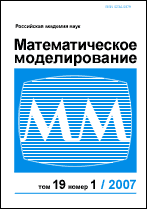|
This article is cited in 3 scientific papers (total in 3 papers)
Simulations of nanoscale gas flow with Knudsen diffusion and slip flow
I. S. Nesterovaa, K. M. Gerkeb
a Moscow Institute of Physics and Technology
b Shmidt Institute of Physics of the Earth
Abstract:
The traditional oil and gas reservoirs used for hydrocarbon production have been partially exhausted and the global energy market is looking for new unconventional energy sources. According to some estimates, shale gas resources in the world amount to 200 trillion m$^3$, but only a small part is recoverable from the point of view of modern technologies. A detailed understanding of shale petrophysics is necessary to start production. In this paper, we compare the popular Javadpour's empirical model against direct calculations of the gas flow in a nanocapillary. The study was performed on a range of flow regimes from the Stokes flow to the free molecular flow. Although in general the empirical model always gives higher predictions in comparison with calculations, these differences are minimal for pores with a radius of $\sim$ 1–20 nm. In the range of pore radii of $\sim$ 20–1000 nm, the results of the two approaches disagree significantly. Based on the data obtained, it can be safely stated that direct modelling of nanoflows can serve as a significant refinement when modelling such flows using pore-network models, since instead of empirical models for round nanocapillaries, we can use calculations for pores of any configuration. In the future, it will be of great interest to conduct a deeper study, including accounting for non-ideal gas and performing simulations for geometry of real pores obtained experimentally from geological samples, which will reliably parameterize the pore-network models of gas nano-flow.
Keywords:
nanoscale gas flow, Knudsen diffusion, slip flow.
Received: 27.07.2020
Revised: 21.09.2020
Accepted: 26.10.2020
Citation:
I. S. Nesterova, K. M. Gerke, “Simulations of nanoscale gas flow with Knudsen diffusion and slip flow”, Matem. Mod., 33:3 (2021), 85–97; Math. Models Comput. Simul., 13:6 (2021), 971–978
Linking options:
https://www.mathnet.ru/eng/mm4273 https://www.mathnet.ru/eng/mm/v33/i3/p85
|

| Statistics & downloads: |
| Abstract page: | 382 | | Full-text PDF : | 64 | | References: | 49 | | First page: | 13 |
|




 Contact us:
Contact us: Terms of Use
Terms of Use
 Registration to the website
Registration to the website Logotypes
Logotypes








 Citation in format
Citation in format 
